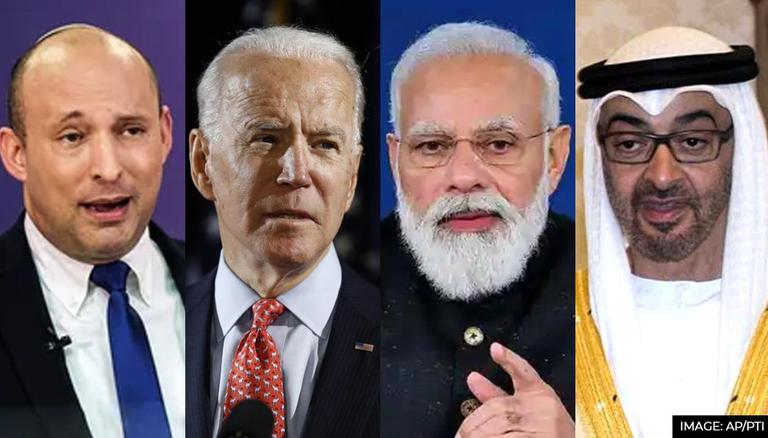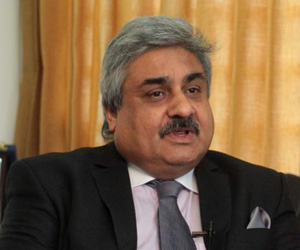
India, The Middle East and The New Quad

The inaugural meeting between the foreign ministers of India, Israel, the United Arab Emirates, and the United States had taken place on October 20, 2021 with India’s S. Jaishankar and Israel’s Yair Lapid joining in person and US Secretary of State Antony Blinken and UAE Foreign Minister Sheikh Abdullah bin Zayed Al Nahyan joining the meeting virtually. Interestingly, the foreign ministers of three members of this new quad had met together the previous week in Washington to review the progress in the Abraham Accords between Israel and the UAE, signed in August 2020. This New Quad added India to that trilateral. It is clear that the Abraham Accords laid the basis of this New Quad grouping.
Whether it turns out to be something significant remains to be seen but the basis of a sound partnership has been laid. The Biden administration is actively involved in responding to China in different regions. It has invigorated the Indo-Pacific Quad, and established AUKUS to meet China’s challenge. The establishment of a New Quad in the Middle East reflects a recognition that the China challenge goes beyond the South China Sea and the Pacific and has to be met in other parts of the Indo-Pacific as well.
A similar motivation seems to be driving the Indian involvement. After the Galwan confrontation in 2020, and China’s continued aggressive actions along the Line of Actual Control (LAC), India has become much more forthcoming on the Indo-Pacific Quad. India joining this new Middle Eastern Quad is a recognition that the China threat has to be met not only on the Line of Actual control but also toward India’s west. It must be borne in mind that for India, the Indo-Pacific extends from the Southern Pacific and Guam to the shores of East Africa, because both for India and for China, the Indian ocean and the Arabian Sea and the choke points which lie therein as well as the sea lanes of communication, are important. Both India and the US now need each other to meet the China challenge. Times have changed, and India is now seen as a valuable partner for the US, in the Indo-Pacific and in other parts of the world.
This is something novel for India, but India also realizes that the United States is needed to counter China’s spreading influence. It is also a reflection of India’s growing comfort in dealing with the United States and its growing trust in the US. Both these Quad groupings – in the Indo-Pacific and in the Middle East – are a reflection of the understanding that the China challenge is not just a military one but far broader, which includes political and economic aspects. So, while the focus in the Indo-Pacific Quad may be on the Chinese military challenge, in the Middle East it is more on the economic influence.
China’s influence in the Middle East, particularly in Israel and the UAE, had been growing despite the fact that both are close US security partners. China has quickly moved to fill in the vacuum left by the US withdrawal from middle East which started under President Obama. The Bosporus, the Dardanelles, Bab Al Mandab and the Hormuz Straits as well as the Suez Canal are all important for China. China has therefore developed comprehensive partnerships with Saudi Araba, Egypt and UAE, and its influence over Iran has increased significantly with the signing of a 25-year cooperation Plan. It has strategic partnerships with Djibouti, Iraq, Jordan, Kuwait, Morocco, Oman, Qatar and Turkey.
Chinese BRI plan in the region encompasses a network of railways, highways, energy pipelines and 50 special economic zones. More than 60 countries of the region have signed on to the BRI. In most cases these BRI projects have an opaque bidding process, and require the use of Chinese firms. In many cases Chinese companies have been forming joint ventures with members of the royal family in monarchies of the region, and contractors have inflated costs leading to a backlash. However, GCC states feel plagued by western exhortations on human rights and democracy, and see China as a country which does not bother them with such demands.
Recently, there had been reports that the US prevailed upon the UAE to stop China from constructing what it said was a secret military facility at Abu Dhabi port. But the most concrete example of US working with Israel and UAE can be seen in the port of Haifa, a part of which was being developed by the Chinese. The American fifth fleet is a regular visitor there and the US prevailed upon the Israelis to form a joint venture between Israel shipyards with DP world of the UAE to develop another part of the port so that the Chinese and US interests are balanced.
Israel and the UAE are seen as ideal partners for India and the United States which was a necessary plank for putting together a Middle Eastern Quad. Israel’s prowess in military and civilian areas is well known. The UAE is also gearing up for technological advances in areas such as outer space exploration. Through the Abraham Accords, USA brought Israel and the UAE together, thus getting rid of the difficulties of building a Middle Eastern coalition.
India has considerable economic and security interests in the Middle East; it sources around 60% of its crude petroleum imports from the region which is also home to about 8.5 million Indians, accounting for over 45% of India’s inward remittances. It has developed a network of partnerships in the region that is underpinned by cooperation in the fields of maritime security, science and technology, food and energy security, and increasingly investments in manufacturing as well as defense cooperation.
India’s trade with UAE is around US$60 billion. India and the UAE have concluded an early harvest free trade agreement and a bilateral Comprehensive Economic Partnership Agreement. This will boost trade and investment between the two countries to $100 billion. India is also trying to conclude a similar agreement with Israel. The UAE has signed a similar pact with Turkey, and is in the final stages of signing such agreements with Israel and Indonesia. The UAE would like to maintain itself as a business and investment hub, even though its placement by the financial action task force grey list will not allow full play for investments into a country like India. The India-Israeli bilateral trade is close to $4 billion. All these figures are expected to see an upswing as a result of this enhanced cooperation.
So, what is the new Quad supposed to do besides enhancing trade and investments? According to the read outs after the middle east Quad meeting, the Quad discussions identified ‘trade, combating climate change, energy cooperation, and increasing maritime security’, in addition to ‘people to people ties in science and technology, and how to support global public health in relation to the COVID-19 pandemic’, as areas of potential quadrilateral cooperation in the region.
The onus for a quick impact will be on India with its scale, its manufacturing and work force. UAE finances and Israeli technology and innovation and the US diplomatic ability and strategic power can help but all countries will need to shorten timelines and achieve some tangible results quickly. If the experiment succeeds, the grouping could incorporate other partners. However, the partners must avoid the risk of making the group too unwieldy.
India will be happy to work with the other partners on maritime security and countering piracy in the western Indian Ocean. It has tried to increase its naval partnerships with the Arab Gulf states, exchanging high-level visits among naval officers and conducting joint exercises with Oman, the UAE, and Saudi Arabia. Israel and the Arab Gulf countries, which already provide the US and Indian navies with logistical support, can therefore help India in gaining greater access to berthing and logistics facilities. This is a pattern which has been set through the Indo-French agreement on reciprocal logistics support for armed forces which has acted as a force multiplier for India. The UAE is keen on investment in joint production of defense items with India. Besides artificial intelligence, clean and renewable energy technology could be a focus. One example normally cited is that of Indian and Israeli startups joining hands with UAE funding for cutting edge innovation projects in India. Space technology provides another avenue for cooperation.
US-India, and Israel-India have been working on a number of cooperation projects and the Indo-pacific Quad has started work on space cooperation for application in maritime domain awareness. The UAE has also expressed interest in India’s low-cost satellite launch vehicles. India will be happy to receive investments in the 14 Sectors it has identified under its Production Linked Incentive Scheme in order to boost manufacturing. Connectivity and infrastructure in the region have also been mentioned as an area of cooperation but will require targeted projects to be finalized with financing requirements. India would prefer specific investments which could help it in turnround and logistics support, especially at port facilities in the region.
India would like to avoid being drawn into Middle Eastern rivalries or security dynamics. It would like to maintain good relations with Iran, Saudi Arabia, Qatar, UAE and other countries of the GCC besides Israel at the same time because of its specific dependencies on each of these countries. Its huge diaspora presence across these countries is a major factor.
The US interest in the region tends more towards balancing China and keeping its influence in the region intact. The primary Israeli interest seems to be to keep a check on Iranian ambitions, while the UAE will be keen to maintain its economic superiority and its reputation as an investment hub in the region. These diverse interests will need to be understood and balanced. These are still early days for solid actions by these four countries to materialize in the region.
************
Image reference – AP/PTI
Disclaimer
The opinions expressed in this article are the author’s own and do not reflect the views of Chanakya Forum. All information provided in this article including timeliness, completeness, accuracy, suitability or validity of information referenced therein, is the sole responsibility of the author. www.chanakyaforum.com does not assume any responsibility for the same.
Chanakya Forum is now on . Click here to join our channel (@ChanakyaForum) and stay updated with the latest headlines and articles.
Important
We work round the clock to bring you the finest articles and updates from around the world. There is a team that works tirelessly to ensure that you have a seamless reading experience. But all this costs money. Please support us so that we keep doing what we do best. Happy Reading
Support Us





















POST COMMENTS (1)
mukesh.naik